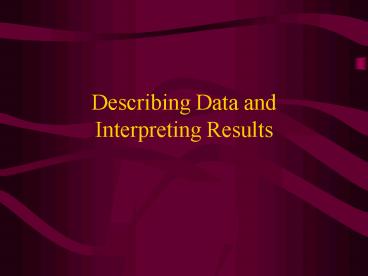Describing Data and Interpreting Results - PowerPoint PPT Presentation
1 / 17
Title:
Describing Data and Interpreting Results
Description:
Use EXPLORATORY DATA ANALYSIS (EDA) to search for patterns in your data. ... Steps involved in EDA: 1. Organize and summarize your data on a data-coding sheet. ... – PowerPoint PPT presentation
Number of Views:47
Avg rating:3.0/5.0
Title: Describing Data and Interpreting Results
1
Describing Data andInterpreting Results
2
Doing Exploratory Data Analysis
- Use EXPLORATORY DATA ANALYSIS (EDA) to search for
patterns in your data. - Before conducting any inferential statistic, use
EDA to ensure that your data meet the
requirements and assumptions of the test you are
planning to use (e.g., normally distributed). - Steps involved in EDA
- 1. Organize and summarize your data on a
data-coding sheet. - 2. If desired, organize data for computer entry.
- 3. Graph data (bar graph, histogram, line graph,
or scatterplot) so that you can visually inspect
distributions. This will help you choose the
appropriate statistics. - 4. Display frequency distributions on a
histogram, and create a STEMPLOT. - 5. Examine your graphs for normality or skewness
in your distributions.
3
(No Transcript)
4
Measures of Center Characteristics and
Applications
- Mode
- Most frequent score in a distribution
- Simplest measure of center
- Scores other than the most frequent not
considered - Limited application and value
- Median
- Central score in an ordered distribution
- More information taken into account than with the
mode - Relatively insensitive to outliers
- Used primarily when the mean cannot be used
- Mean
- Average of all scores in a distribution
- Value dependent on each score in a distribution
- Most widely used and informative measure of center
5
(No Transcript)
6
Measures of Center Applications
- Mode
- Used if data are measured along a nominal scale
- Median
- Used if data are measured along an ordinal or
nominal scale - Used if interval data do not meet requirements
for using the mean - Mean
- Used if data are measured along an interval or
ratio scale - Used if scores are normally distributed
7
Measures of Spread Characteristics
- Range
- Subtract the lowest from the highest score in a
distribution of scores. - Simplest and least informative measure of spread.
- Scores between extremes are not taken into
account. - Very sensitive to extreme scores.
- Semi-Interquartile Range
- Less sensitive than the range to extreme scores.
- Used when you want a simple, rough estimate of
spread. - Variance
- Average squared deviation of scores from the
mean. - Standard Deviation
- Square root of the variance.
- Most widely used measure of spread.
8
Measures of Spread Applications
- Range and standard deviation are sensitive to
extreme scores. In such cases the
sem-iinterquartile range is best. - When your distribution of scores is skewed, the
standard deviation does not provide a good index
of spread. - With a skewed distribution, use the
semi-interquartile range.
9
(No Transcript)
10
The Pearson Product-Moment Correlation (r)
- Most widely used measure of correlation.
- Value of r can range from 1 through 0 to -1.
- Magnitude of r tells you the degree of LINEAR
relationship between variables. - Sign of r tells you the direction (positive or
negative) of the relationship between variables. - Presence of outliers affects the sign and
magnitude of r. - Variability of scores within a distribution
affects the value of r. - Used when scores are normally distributed.
11
Measures of Correlation and Regression
- Pearson Product-Moment Correlation
- Index of linear relationship between two
continuously measured variables - Point-Biserial Correlation
- Index of correlation between two variables, one
of which is measured on a nominal scale and the
other on at least an interval scale - Spearman Rank-Order Correlation (rho)
- Index of correlation between two variables
measured along an ordinal scale - Phi Coefficient
- Index of correlation between two variables
measured along a nominal scale - Linear Regression and Prediction
- Used to find the straight line that best fits the
data plotted on a scatterplot
12
(No Transcript)
13
(No Transcript)
14
(No Transcript)
15
(No Transcript)
16
(No Transcript)
17
(No Transcript)































